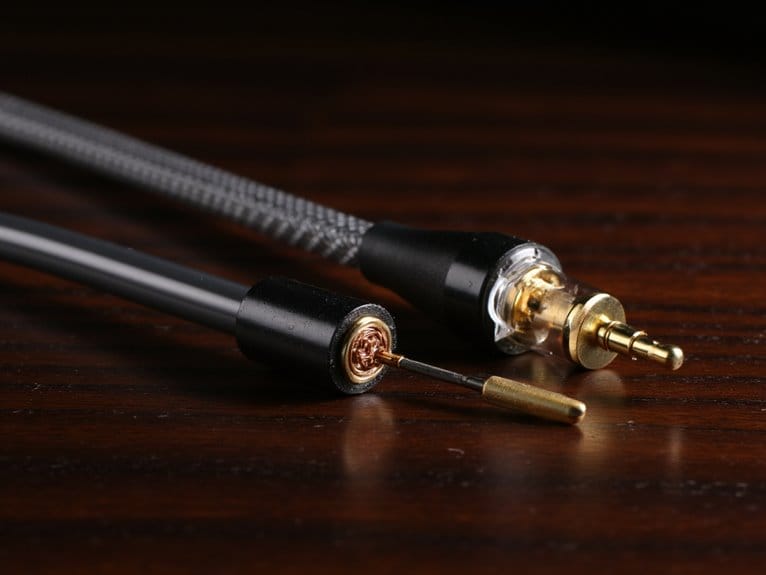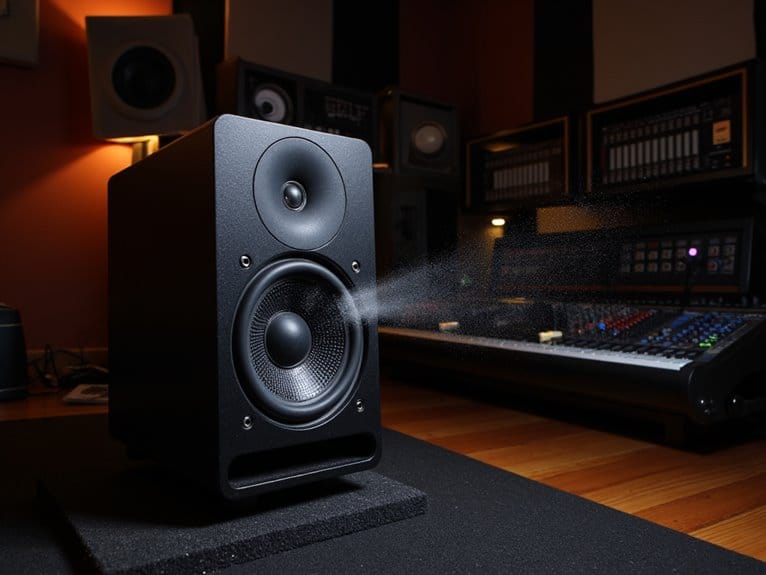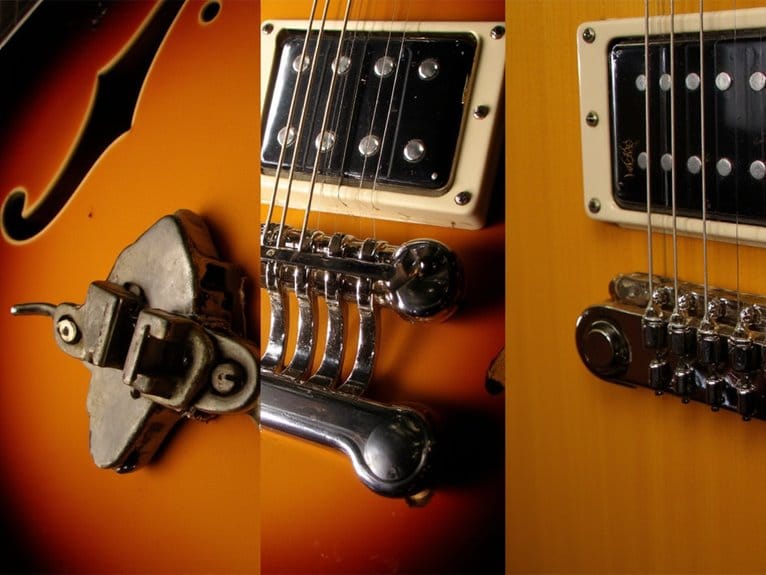Understanding Guitar Nut Materials and Their Effects
Your guitar’s nut material greatly impacts tone, sustain, and tuning stability through its role as a critical vibration transfer point. Bone remains the gold standard, delivering warm resonance and durability, while cheaper plastic nuts compromise sustain and clarity. High-end synthetics like TUSQ offer bone-like properties with consistent density, and graphite-impregnated options reduce friction but may darken your tone. Each material creates distinct tonal characteristics that shape your instrument’s overall sound and performance characteristics.
We are supported by our audience. When you purchase through links on our site, we may earn an affiliate commission, at no extra cost for you. Learn more.
Notable Insights
- Guitar nut material directly affects tone, sustain, and tuning stability by influencing string vibration transfer.
- Bone nuts provide superior acoustic properties with enhanced resonance, warm tone, and excellent durability.
- Plastic nuts range from poor-quality budget options to high-end materials like TUSQ that mimic bone’s tonal characteristics.
- Synthetic materials like graphite reduce string friction for better tuning stability but may darken overall tone.
- Different materials produce distinct sonic signatures: bone offers warmth, brass provides brightness, graphite delivers darkness.
Types of Guitar Nuts and Their Functions
When you’re examining the guitar in your hands, you mightn’t give much thought to that small piece at the headstock end, but I’ve learned that the nut’s design fundamentally shapes how your instrument performs, sounds, and responds to your playing style.
Understanding nut functionality reveals why different types exist, each serving distinct purposes that affect your playing experience.
The most common standard nut provides basic string spacing and height positioning, while compensated nuts improve intonation through precise string contact adjustments.
Standard nuts handle basic string positioning, while compensated designs fine-tune intonation through strategic string contact points.
Locking nuts, typically found on Floyd Rose systems, maintain tuning during aggressive tremolo use, and roller nuts reduce friction for smoother string returns. The roller design incorporates small ball bearings that minimize string binding and enhance tuning stability during bends and vibrato techniques.
Zero-fret nuts offer brighter tones and consistent height settings. This types comparison demonstrates how each design addresses specific musical needs, whether you’re seeking enhanced tuning stability, improved intonation, or reduced string binding issues.
The nut also plays a crucial role in transferring vibrations to the neck, which directly impacts your guitar’s overall resonance and sustain characteristics.
Bone Nuts: The Gold Standard Material
Among all the materials I’ve encountered in guitar construction, bone stands as the undisputed champion for nut applications, offering a combination of acoustic properties, durability, and workability that’s proven nearly impossible to replicate synthetically.
The bone nut advantages extend far beyond simple functionality, delivering superior tonal resonance through dense composition that transfers string energy efficiently to your guitar’s soundboard.
You’ll notice enhanced sustain, improved clarity across all strings, and that coveted warm tone that can tame overly bright instruments.
While I’ve worked with TUSQ and other synthetics that offer consistency, bone’s natural density provides exceptional durability, resisting wear better than plastic alternatives while maintaining precise intonation. Just as professional-grade preamps in audio interfaces deliver superior sound quality despite budget constraints, bone nuts demonstrate that premium materials can significantly impact tonal performance regardless of your guitar’s price point.
Professional luthiers can easily customize bone nuts, shaping them for prime string action and your specific playing requirements. The precise string spacing created by a well-cut bone nut ensures optimal alignment and prevents unwanted buzzing during performance.
Plastic Nuts: From Budget to High-End Options
While bone sets the benchmark for tonal excellence, plastic nuts occupy a surprisingly diverse spectrum that ranges from the genuinely problematic to the impressively capable.
I’ve learned through countless installations that lumping all plastics together represents a fundamental misunderstanding of modern guitar hardware. When you’re examining plastic nut comparisons, you’ll discover that cheap variants on entry-level guitars produce inferior sustain and brittle construction that’ll leave you frustrated, while high-end materials like TUSQ actually mimic bone’s tonal properties with remarkable accuracy.
The high end advantages become clear when you consider TUSQ’s self-lubricating properties and consistent density, or Corian’s robust performance that bridges budget constraints with professional requirements. This proves that modern plastics can deliver genuine value.
Synthetic and Composite Materials for Modern Guitars
The engineering brilliance behind modern synthetic and composite materials has revolutionized guitar nut performance in ways that frankly surprised me when I first started installing them. This has created purpose-built solutions that address specific performance challenges while matching or exceeding traditional materials in key areas.
Tusq delivers bone-like tone with remarkable synthetic durability, while its XL variant adds PTFE lubrication for tremolo stability. Corian and Micarta offer reliable composite performance in production guitars, providing consistent density without natural material inconsistencies.
Graphite-impregnated options like Slipstone reduce string friction dramatically, though they’ll darken your tone slightly. What impresses me most is how these materials can be engineered for specific goals—whether you need enhanced lubrication, targeted hardness, or environmental resistance that natural materials simply can’t match consistently.
How Nut Materials Shape Your Guitar’s Sound and Performance
Why does swapping your guitar’s nut material create such dramatic changes in tone and playability when it’s such a small component?
The nut acts as a critical vibration transfer point, directly influencing how string energy transmits to your guitar’s body and neck. Bone delivers exceptional tone warmth and sustain through its dense structure, while brass provides brilliant articulation that cuts through mixes but can sound harsh to some players.
Graphite offers darker tones with superior tuning stability thanks to its self-lubricating properties, making it ideal for tremolo-equipped guitars. Meanwhile, synthetic materials like Tusq balance warmth with consistency, though they lack bone’s natural resonance complexity.
Your choice fundamentally shapes sustain, brightness, and string response characteristics.
Frequently Asked Questions
Can I Replace My Guitar Nut Myself or Do I Need Professional Installation?
You can replace your guitar nut yourself with proper nut replacement tools and patience. DIY guitar maintenance like this requires careful preparation, but it’s definitely achievable if you’re comfortable working with small parts.
How Often Should Guitar Nuts Be Replaced During Normal Playing Conditions?
You’ll rarely need to replace guitar nuts during normal playing since they’re designed for guitar longevity. Unlike strings, nut wear occurs very slowly over several years, making replacement infrequent unless damage occurs.
Do Different Nut Materials Require Specific Maintenance or Cleaning Techniques?
Yes, you’ll need different cleaning methods for proper nut care. Bone nuts require gentle damp cloths, synthetic nuts tolerate mild soap, wooden nuts need specialized oils, and metal nuts require soft cloths with metal polish.
Will Changing My Nut Material Void My Guitar’s Warranty Coverage?
Changing your nut material will likely void your guitar’s warranty coverage due to warranty limitations on modifications. Manufacturers typically require original material standards to maintain valid warranty protection on your instrument.
Can Nut Height Adjustments Fix String Buzzing and Intonation Problems?
Yes, adjusting nut height can fix both problems. Proper nut height eliminates open string buzzing by providing adequate fret clearance, while correct string action at the nut improves intonation accuracy and tuning stability.
On a final note
You’ll discover that nut material choice greatly impacts your guitar’s tone, sustain, and playability more than you’d expect. Whether you’re upgrading from plastic to bone, experimenting with synthetic composites, or exploring premium materials, each option delivers distinct sonic characteristics that’ll transform your playing experience. Don’t underestimate this small component’s influence—it’s one of the most cost-effective modifications you can make to enhance your instrument’s overall performance and responsiveness.







